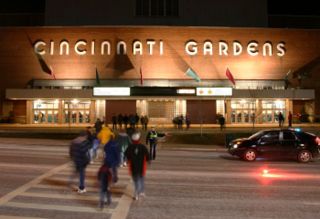 | |
 | |
| Location | 2250 Seymour Avenue Cincinnati, Ohio 45212 |
|---|---|
| Coordinates | 39°10′52″N 84°27′19″W / 39.18111°N 84.45528°W |
| Owner | Kenko Corporation (Robinson family) |
| Operator | Kenko Corporation |
| Capacity | 10,208 |
| Surface | Concrete (ice floor) |
| Construction | |
| Opened | February 22, 1949 |
| Closed | July 21, 2016 |
| Demolished | March 2018 |
| Construction cost | $3 Million ($38.4 million in 2023 dollars[1]) |
| Tenants | |
| Cincinnati Mohawks (AHL / IHL) (1949–1958) Xavier Musketeers (NCAA) (occasional 1949–1979, permanent 1983–2000) Cincinnati Bearcats (NCAA) (1949–1954, 1987–1989) Cincinnati Royals (NBA) (1957–1972) Cincinnati Wings (CPHL) (1963–1964) Cincinnati Swords (AHL) (1971–1974) Cincinnati Slammers (CBA) (1984–1987) Cincinnati Cyclones (ECHL / IHL) (1990–1997) Cincinnati Silverbacks (NPSL) (1995–1997) Cincinnati Mighty Ducks (AHL) (1997–2005) Cincinnati Rollergirls (WFTDA) (2006–2016) Cincinnati Commandos (UIFL/CIFL) (2010–2012) Cincinnati Kings (PASL) (2010–2012) Cincinnati Thunder (NA3HL) (2015–2016) | |
Cincinnati Gardens was an indoor arena located in Cincinnati, Ohio, that opened in 1949. The 25,000 square foot (2,300 m2) brick and limestone building at 2250 Seymour Avenue in Bond Hill had an entrance that was decorated with six three-dimensional carved athletic figures. When it opened, its seating capacity of 11,000+ made it the seventh largest indoor arena in the United States.
The Cincinnati Gardens' first event was an exhibition hockey game. It has been the home of six league championship hockey teams, and most recently was the home of the Cincinnati Mighty Ducks of the American Hockey League. It also has been host to numerous other sporting events, concerts, stage shows, circuses, and political rallies. The Gardens' final tenants were the Cincinnati Rollergirls of the Women's Flat Track Derby Association and the Cincinnati Thunder of the North American 3 Hockey League.
In 2013, the Robinson family, which had owned the Gardens since 1979, put the arena up for sale. The family-controlled company, Kenko Corporation, no longer considered the arena a core asset.[2] On June 16, 2016, the Port of Greater Cincinnati Development Authority approved a contract to acquire the property for $1.75 million from the Robinson family, which intended to repurpose the 19-acre (7.7 ha) site for future light manufacturing.[3] Demolition took place in March 2018.[4]
- ^ 1634–1699: McCusker, J. J. (1997). How Much Is That in Real Money? A Historical Price Index for Use as a Deflator of Money Values in the Economy of the United States: Addenda et Corrigenda (PDF). American Antiquarian Society. 1700–1799: McCusker, J. J. (1992). How Much Is That in Real Money? A Historical Price Index for Use as a Deflator of Money Values in the Economy of the United States (PDF). American Antiquarian Society. 1800–present: Federal Reserve Bank of Minneapolis. "Consumer Price Index (estimate) 1800–". Retrieved February 29, 2024.
- ^ Steve Watkins (July 9, 2013). "Cincinnati Gardens owner Robinson explains why his family is selling". Cincinnati Business Courier.
- ^ Engel, Liz (15 June 2016). "Port Authority buys Cincinnati Gardens with plans to demolish arena to make way for manufacturing". WCPO.com. E.W. Scripps. Retrieved 15 June 2016.
- ^ "Cincinnati gardens demolished". Archived from the original on 2021-12-21 – via www.youtube.com.